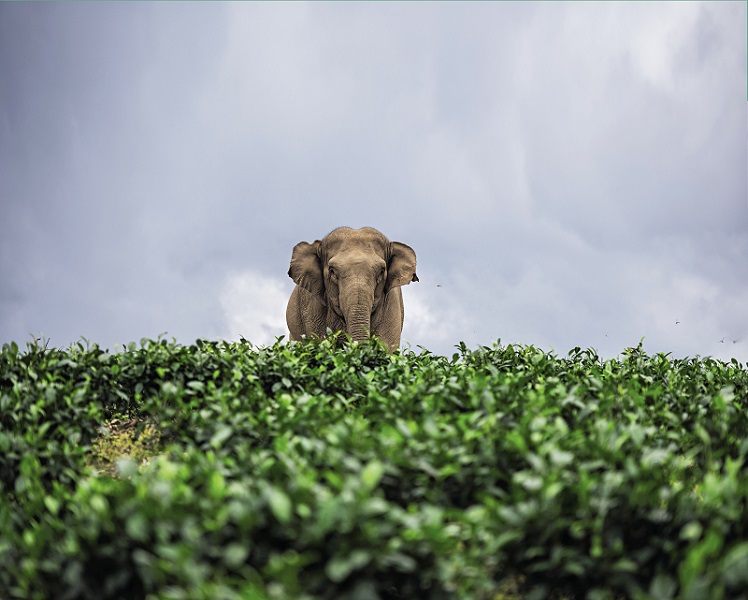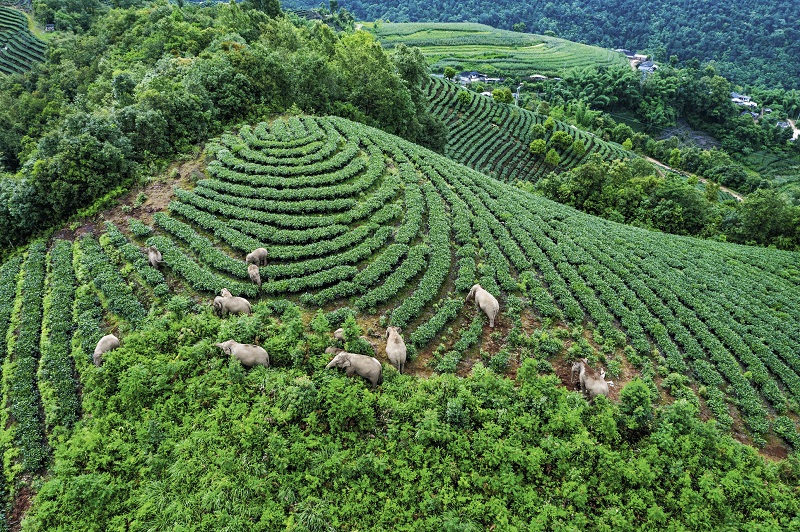In March 2020, a herd of 15 Asian elephants ran away from their home in the Xishuangbanna National Nature Reserve in southwest China’s Yunnan Province. They headed northward and roamed around for more than 1,300 kilometers before returning home on August 12, 2021.
Yunnan provincial authorities deployed police officers, workers, trucks, and drones to monitor the herd 24 hours a day. Around 180 tonnes of food was fed to the elephants. These wandering animals caused quite a stir on Chinese and foreign social media platforms.
Zhang Xiong is the head of a drone team of the search squad for the wild Asian elephants sent by the Yunnan Forest Fire Brigade. He said his team had been closely monitoring the herd for more than seven days, providing first-hand intelligence to ensure the safety of people and animals.

An elephant walks through Zhushan Village in Yunnan Province on August 7, 2021.
Guardians of the Elephants
Zhang was one of the first to join the elephant search team. Since the local fire season had just ended in late May, he was planning a honeymoon with his wife. “I have been a fan of elephants since my childhood. When I heard that the brigade was planning to set up a search team to watch and track the stray Asian elephants, I was the first to sign up,” he said.
On May 27, 2020, Zhang, appointed to be head of the drone fleet monitoring the herd, arrived at a surveillance site in Yuxi City. After consulting his colleagues and gathering basic knowledge of the drone flight online, he captured scenes of the herd roaming around the streets for the first time.
“Flying a drone is really a professional job that requires careful attention,” he commented. “At the most critical moments, we slept only four hours a day, and sometimes we would follow the herd for tens of kilometers into the mountains.”
Having no prior knowledge of animal activity, he learned about the daily living habits of elephants and experienced unexpected enjoyment. “Every elephant in the herd has a role to play. An adult female elephant leads the group, while the males play the role of guardian. The younger elephants are mischievous. Young elephants fight every now and then, and the baby elephants are really cute. The herd often scans the local environment before setting out in search of food and determining routes to protect the calves from danger by avoiding populated areas.”
The monitoring of wild Asian elephants was not limited to just knowing their position; a priority was to observe the distance between them and humans to prevent confrontations and better ensure the safety of both people and elephants. In addition, all herd activities should be recorded in order to provide data for scientific research. “Based on the surveillance data, experts in the headquarters can plan a better migration route for elephants and predetermine feeding locations.”
During the surveillance, Zhang and his team followed the herd in the mountains and transferred surveillance locations more than 200 times. Sometimes the elephants raised their trunks to greet the drones, and sometimes the “little ones” played with dogs, chickens, and goats they met along the way. But they also “stole” bananas, sugar cane, corn, and other food from local crops. “Wherever the elephants went, the villagers were very friendly to them and tried to let them eat as much as they needed. They hit it off.”

The elephant herd roaming through a tea garden in Zhushan Village in Yunnan Province on August 7, 2021.
Mahout of the Elephants
The elephant’s “happy journey” didn’t always go smooth. On the way back, they encountered many obstacles, the most important of which was crossing the Yuanjiang River.
The Yuanjiang River, one of the oldest rivers in Yunnan, is a dividing line for the habitat of Asian elephants. It is therefore an important geographical landmark for the herd on its way back to its original habitat.
The herd had successfully crossed the Yuanjiang River during a low water period back in April. However, as they headed back, the water level had risen, preventing the elephants from crossing it several times. In order to help them return to the south safely, working groups sent by local authorities delved into the situation and decided to guide the herd to an old bridge, where they could cross.
“Despite its abundance of food and water, the Yuanjiang River basin is not suitable for the herd to stay due to its poor sheltering conditions. Once they cross the river, the elephants will have a more suitable living environment,” said Yang Yingyong, a senior official with Yuxi City. The herd deviated from the planned route several times, but after 13 days and 12 nights of joint efforts, local authorities managed to help the elephants cross the old bridge over the Yuanjiang River.
Shen Qingzhong, a senior engineer at the Xishuangbanna National Nature Reserve, said that in the past, Asian elephants used to live around a large area from the Yellow River basin to the Yunnan-Guizhou Plateau, and that their migration was normal. “Migration helps wild elephants find new habitats and transfer genes to other herds,” he added. Elephant herds have a strong adaptive capacity, accumulating and passing on the experience of successfully crossing each mountain and bridge, or of using man-made facilities.
For the protection of wild Asian elephants, China’s National Forestry and Grassland Administration and the Yunnan provincial government have agreed to promote the construction of national parks. According to Shen, at the present stage, it is crucial to quickly set up a comprehensive monitoring and control system, and use appropriate technical means to effectively manage the movement of Asian elephants. “It is necessary to prevent herds of the elephants from large-scale migration,” he said.

Members of the elephant herd tracking team monitor the herd’s movements with a drone.
Example for Species Protection
Chen Fei, director of the Asian Elephant Research Center of the National Forestry and Grassland Administration, said that several experts and technicians from the wildlife, information and communication sectors, and other fields concerned had participated in the efforts to ensure the safety of the elephants since they left their habitat. “It is a process of helping the elephants and observing them for scientific study. A large amount of data has been kept for future research, monitoring and early warning, and emergency response.”
The odyssey of the wild Asian elephants in Yunnan provided the domestic and foreign audiences with some knowledge of China’s efforts in preserving wildlife and biodiversity over the past decades. It should be noted that the number of wild Asian elephants in Yunnan has increased from around 150 in 1978 to currently more than 300, and that their numbers are still growing.
In the mid-1990s, wild Asian elephants in Yunnan could only be found in Xishuangbanna and Nangunhe national nature reserves. By the end of 2020, the Asian elephant activity zones had expanded to 55 townships in 11 county-level regions of three prefectural cities across the province, and they often went outside the nature reserves. The locals have become accustomed to the presence of wild animals in their villages, and their awareness and ability to protect wildlife is increasing steadily.
To date, 11 nature reserves have been established around the habitat of wild Asian elephants in China. The total area has reached 509,800 hectares. To further strengthen the protection and management of Asian elephants, the Asian Elephant Research Center of the National Forestry and Grassland Administration was established in December 2019 in Kunming, Yunnan Province.
Besides, China is encouraging international cooperation in protecting Asian elephants. The Xishuangbanna National Nature Reserve has signed cooperation agreements with three provinces in northern Laos, forming five joint conservation areas with the total area reaching 133 square kilometers.
“In the future, protection work should be based on the needs of Asian elephants,” said Chen Mingyong, professor with the School of Ecology and Environmental Science at Yunnan University. He advised building habitats in areas where wild Asian elephants are traditionally present.
The key to maintaining the balance between the needs of Asian elephants and the survival and development of local people lies in transforming the approach to development. In the future, instead of farming, local people can be encouraged to develop eco-tourism in a moderate manner. With fewer frictions and overlapping areas of respective activities, humans and elephants can live together in harmony.